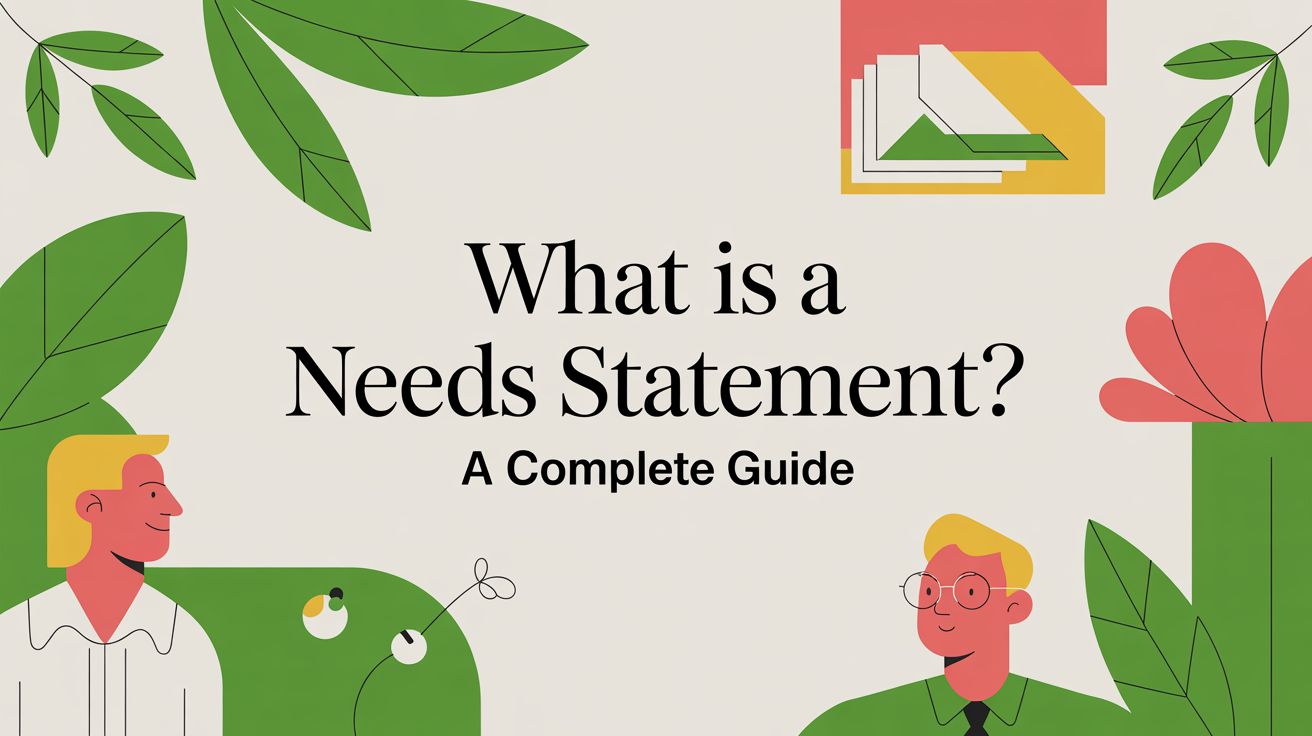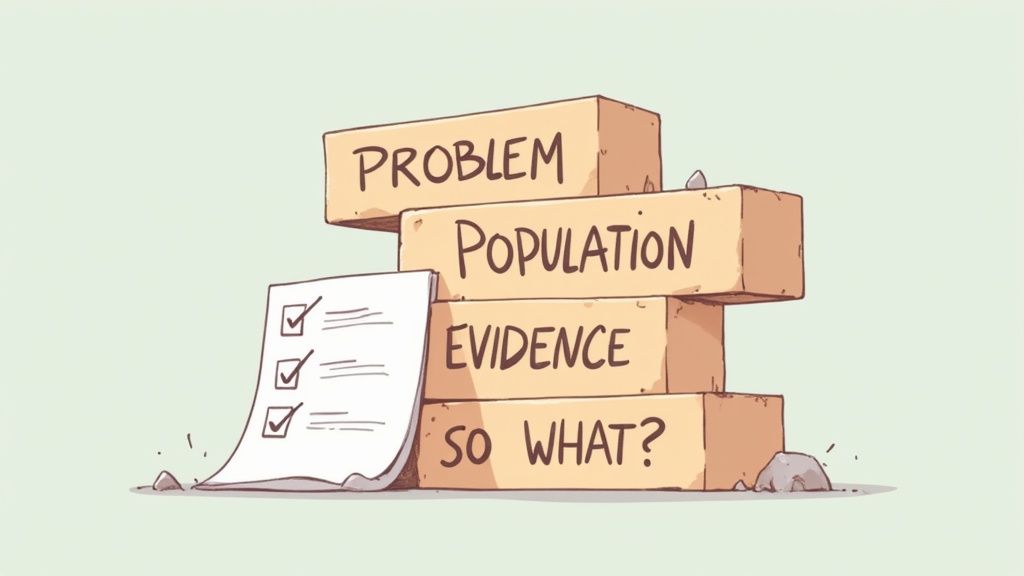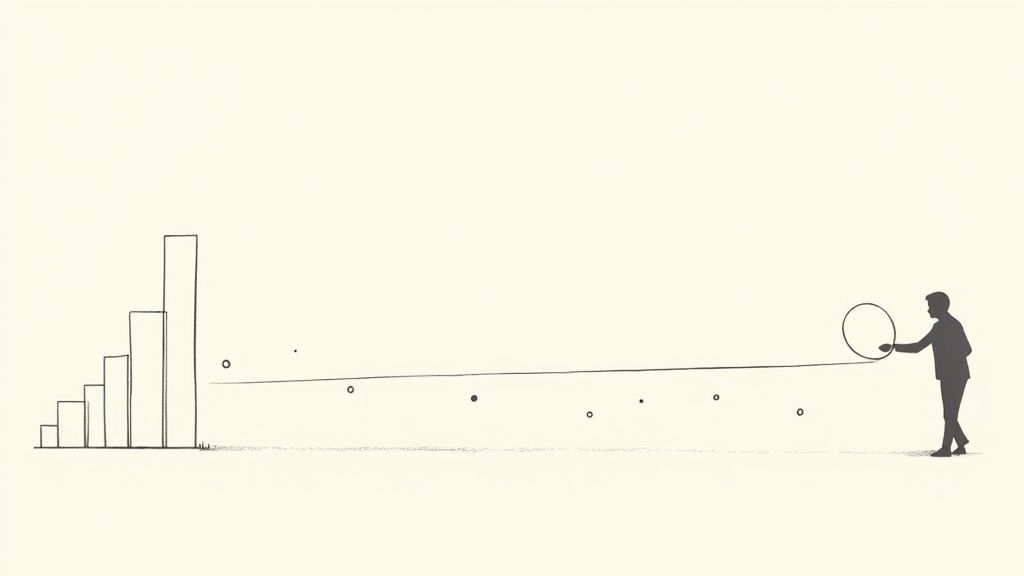What Is a Needs Statement? A Complete Guide
What is a needs statement? Learn how to write a compelling story that frames the problem, uses data effectively, and secures the grant funding you need.

At its heart, a needs statement is the story that answers a funder’s most critical question: "Why should we care?" This is the part of your grant proposal where you frame an urgent problem, explain who it impacts, and make a compelling case for why your support is needed right now.
The Heart of Every Grant Proposal

Think of your needs statement as the opening argument in a courtroom. You're not just asking for something; you're presenting undeniable evidence to convince the jury—the funder—that a real problem exists and your nonprofit is the one to solve it. A truly great needs statement builds a bridge, connecting a community's struggles to a funder's mission to make a difference.
This section is the bedrock of your entire proposal. Before you can dive into your amazing programs or lay out a budget, you have to establish why any of it matters. It provides the crucial context that turns a simple ask for money into a powerful opportunity for partnership.
Shifting from Problem to Opportunity
A strong needs statement does more than just describe a negative situation; it reframes the problem as an opportunity for meaningful change. This is the subtle but critical shift that separates a good proposal from a great one.
An effective needs statement doesn't just describe what's wrong; it creates a vision for what could be right. It establishes the "before" picture so the funder can clearly see the value of investing in the "after."
To pull this off, your statement needs to hit a few key points:
- Define the Problem: Get straight to the point. Clearly and concisely articulate the specific issue your project is designed to tackle.
- Establish Urgency: Explain why this problem demands attention now. What happens if we do nothing?
- Connect to Your Mission: Draw a direct line from the need you've identified to your organization's core purpose.
Mastering this component is what sets the stage for the rest of your proposal. To see how this section fits into the bigger picture, check out our guide on what is a grant proposal.
Building Your Needs Statement Brick by Brick

A powerful needs statement isn't just a single block of text. Think of it as a carefully constructed argument, built from distinct, essential pillars. You're the architect, and your job is to design a case so solid that funders can't help but see its strength and logic.
Each component must be present and well-defined to support the weight of your funding request. Get this part wrong, and the rest of your proposal will feel shaky.
The Four Pillars of a Persuasive Statement
To build a truly compelling argument, you need to assemble four key elements. Each one answers a specific question a funder will inevitably have, guiding them from understanding the problem to recognizing why your solution is necessary.
Here’s a breakdown of what you absolutely must include:
- The Problem: This is your foundation. State the specific issue you’re tackling, but don't be vague. Avoid broad generalizations and zero in on a localized, manageable problem that your organization can realistically address.
- The Population: It's time to put a human face on the issue. Who is most impacted by this problem? Get specific about their demographics, location, and the unique challenges they face. This isn't just about numbers; it's about people.
- The Proof: This is the mortar that holds everything together. You need evidence. Use a mix of quantitative data (statistics, local reports, survey results) and qualitative evidence (stories, client testimonials, expert quotes) to prove the problem is real, urgent, and significant.
- The Consequences: Finally, you have to answer the "so what?" question. What happens if this problem goes unaddressed? Frame inaction as a tangible risk to the community's health, stability, or well-being. This creates a sense of urgency.
To help you organize these thoughts, here’s a quick-reference table that breaks down each component.
Table: Key Components of an Effective Needs Statement
Think of these components as the building blocks for a seamless and persuasive narrative.
From Blueprint to Reality
As you gather these elements, your goal is to weave them into a story. For example, you might start with a startling statistic to frame the scope of the problem, then immediately follow it with a brief, powerful story that illustrates its human cost.
This blend of cold, hard facts and emotional resonance is the secret to creating a truly compelling case for support.
Building this section correctly is a critical step in the grant writing journey. For a deeper look at the entire procedure, check out our complete guide on how to write grants for nonprofits. By methodically assembling these pillars, you create a needs statement that is not only well-reasoned but also deeply resonant.
Weaving Data and Stories into a Compelling Narrative

Think of data as the logical backbone of your needs statement. It provides the proof, the scale, and the credibility that funders need to see. But let's be honest—data on its own is dry. It rarely inspires someone to pull out their checkbook.
That’s where stories come in. Stories give your numbers a soul. They turn abstract statistics into urgent, real-world problems that demand a solution.
The real magic happens when you masterfully blend these two elements. You want to build a case that convinces a funder on both an intellectual and an emotional level. This is how you frame the problem in a way that truly lands.
Humanizing Your Data
Here's a rule I always follow: never let a powerful statistic stand alone. Your job is to immediately connect that number to a tangible human impact. We call this "humanizing the data," and it’s the key to making the problem feel immediate and relatable.
It’s a simple but powerful shift in framing. For instance, instead of just dropping a number, you paint a picture with it:
- Data-Only: "Our city has a high school dropout rate of 25%."
- Humanized Data: "A 25% high school dropout rate isn't just a number. It means that every year, dozens of teens right here in our community face a future with severely limited opportunities, perpetuating a cycle of poverty."
See the difference? That second version connects the statistic to real lives and futures at stake. It creates an urgency that the number alone just can't muster.
The most persuasive needs statements achieve a powerful synergy. They use data to establish the scope of the problem and then deploy stories to illustrate its human cost, making the need for intervention undeniable.
This isn't just a hunch; the results back it up. Analyses of grant outcomes consistently show that proposals with strong, evidence-based needs statements have a 45-50% higher chance of getting funded. As detailed in a review from Unlock Grants on the impact of strong needs statements, a major factor is combining hard data with compelling narratives that focus on specific communities.
When you weave these elements together, your project feels like a timely and critical intervention, not just another proposal in a massive pile. You’re telling a story that a funder simply can't ignore.
Powerful Needs Statement Examples That Work

Theory is one thing, but seeing these principles in action is where the real learning happens. Let's move from the "what" to the "how" by looking at a few real-world examples. The best way to really get a feel for writing a strong needs statement is to see how others have done it well.
We'll start with a classic grant writing pitfall: focusing on what your organization needs instead of what the community needs. It's an easy trap to fall into.
Here’s a common first-draft attempt.
Before: A Vague and Unfocused Statement
"The Art Explorers program needs funding to continue our after-school classes. We need to buy more art supplies and pay our instructors. Without this program, local kids won't have a creative outlet."
See the problem? It’s all about “us, us, us.” It reads like a shopping list for the nonprofit, not a compelling case for community change. A funder can easily pass on this.
Now, let's see what happens when we flip the script.
After: A Data-Driven, Compelling Narrative
"In our community, 45% of middle school students are unsupervised between 3 PM and 6 PM, a timeframe when juvenile crime rates triple, according to the City Police Department. Furthermore, budget cuts have eliminated all in-school arts education for these same students. This leaves hundreds of young teens without safe, structured environments or creative outlets, putting them at significant risk for negative outcomes and stifling critical cognitive development."
This version is a complete game-changer. It's not about needing art supplies anymore; it's about giving kids a safe place to be and a chance to thrive. It zeros in on a specific problem (unsupervised youth), backs it up with hard data (45% of students, crime stats), and clearly spells out the consequences (increased risk, stifled development).
Example 1: The After-School Arts Program
Building on that stronger version, here's how it might look as a fully formed needs statement in a grant proposal.
“In the Northwood district, 45% of middle school students are unsupervised between 3 PM and 6 PM. This critical window corresponds with a threefold increase in juvenile crime, as reported by the City Police Department. Compounding this issue, recent city-wide budget cuts have entirely eliminated in-school arts education, leaving these 500+ students without access to creative learning. This deficit not only increases their risk of engaging in negative behaviors but also deprives them of developing crucial skills like critical thinking and emotional regulation, which arts education is proven to foster.”
Why It Works:
- The Problem: It clearly defines the twin issues—unsupervised teens and no arts education.
- The Population: It gets specific: "middle school students in the Northwood district."
- The Evidence: It uses persuasive data (45%, threefold increase) and gives credit to a reliable source (City Police Department).
- The Consequences: It paints a clear picture of what’s at stake if nothing changes.
Example 2: The Local Food Security Initiative
Let’s shift gears to a different sector. This example tackling food insecurity masterfully blends statistics with a human element to create a sense of real urgency.
“According to the County Health Department’s latest report, one in four families in the East Valley neighborhood lives in a food desert, more than a mile from the nearest full-service grocery store. This lack of access forces 3,000 residents, including over 800 children, to rely on processed foods from convenience stores, leading to a local childhood obesity rate that is 20% higher than the national average. Without intervention, these children face a lifetime of diet-related health complications, perpetuating a cycle of poverty and poor health.”
Why It Works:
- The Problem: It uses a powerful term, "food desert," and connects it directly to a health crisis.
- The Population: It’s not just "families," it's "one in four families in the East Valley neighborhood," including a heartbreaking "800 children."
- The Evidence: It leans on a credible source (County Health Department) and provides specific, impactful numbers (one in four, 3,000 residents, 20% higher).
- The Consequences: The long-term outlook is sobering: "a lifetime of diet-related health complications."
These examples show a needs statement at its best. It’s more than just a paragraph; it’s a concise, evidence-backed story that makes the problem completely impossible to ignore.
Common Mistakes That Weaken Your Proposal
Even the most powerful mission can fall flat if the needs statement is poorly framed. Honestly, knowing what not to do here is just as important as knowing what you should be doing. The single most common mistake I see is when nonprofits describe their own needs instead of the community's problem.
For example, writing "we need a new van" puts your organization's wish list front and center. A much stronger approach is to explain why that van is necessary: “Seniors in our rural community are missing 30% of their vital medical appointments due to a lack of reliable transportation.” See the difference? The focus immediately shifts to the people you serve and the real-world problem they face.
Avoiding Common Grant Writing Traps
Another trap I see people fall into is using circular logic. Arguing that "the problem is our program doesn't exist yet" doesn't actually prove a problem exists at all. You have to first demonstrate the underlying community issue that your program is designed to solve.
Finally, resist the urge to rely on generic national statistics. A funder in your city wants to understand the challenges in their own backyard, not what the national average looks like. Tying your data to local realities makes the need feel urgent and real.
A needs statement fails when it talks about what the nonprofit wants instead of what the community lacks. Always put the community’s problem, backed by local evidence, at the center of your story.
To keep yourself on track, run through this quick mental checklist:
- Does my statement clearly define the problem before I even hint at a solution?
- Is my argument backed up with specific, local data and powerful stories?
- Have I avoided circular reasoning and focused squarely on an external, community need?
Nailing this section is just as critical as having a solid financial plan. You can learn more about building a strong one with our grant proposal budget template.
Your Questions About Needs Statements Answered
Alright, let's get into the nitty-gritty. Writing a needs statement often brings up a few practical questions. Here are some quick answers to the most common ones I hear from fellow grant writers.
How Long Should My Needs Statement Be?
Every funder is different, so their guidelines are your number one rule. But if they don't specify, a good rule of thumb is to aim for one to two pages, or about 500-800 words.
The real goal is to be concise but thorough. You need to give the grant reviewer enough solid evidence to understand the problem without burying them in details. Think of it as making a powerful, to-the-point argument.
Should I Use More Statistics Or More Stories?
This is a classic question, and the answer is: you absolutely need both. They work together to create a complete picture.
Statistics give your argument credibility and scale, appealing to the logical side of the brain. Stories give it a heart, creating an emotional connection that shows the real-world impact on people.
A fantastic approach is to lead with a powerful statistic to frame the problem, then immediately follow up with a short, personal story that brings that number to life.
What If My Community Has Limited Official Data?
This is a common hurdle, especially for smaller or rural nonprofits. If you can't find hyper-local data, it’s time to get creative. You can start by using data from a similar community, but be sure to explain why it's a relevant comparison.
Even better, you can generate your own powerful evidence. Think about:
- Conducting community surveys
- Holding focus groups
- Interviewing local leaders and stakeholders
- Gathering firsthand testimonials from your clients
Don't underestimate the power of qualitative data. A heartfelt quote from someone you've helped can be just as convincing as a page full of statistics. It proves the need is real and urgent.
Crafting the perfect needs statement takes time, but you don't have to do it alone. Fundsprout uses AI to help you find funding opportunities and write compelling grant narratives backed by your organization's data. Discover how to streamline your grant writing process at https://www.fundsprout.ai.
Try 14 days free
Get started with Fundsprout so you can focus on what really matters.
